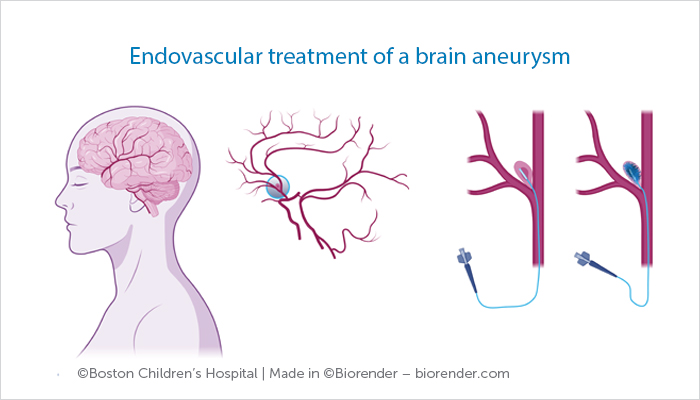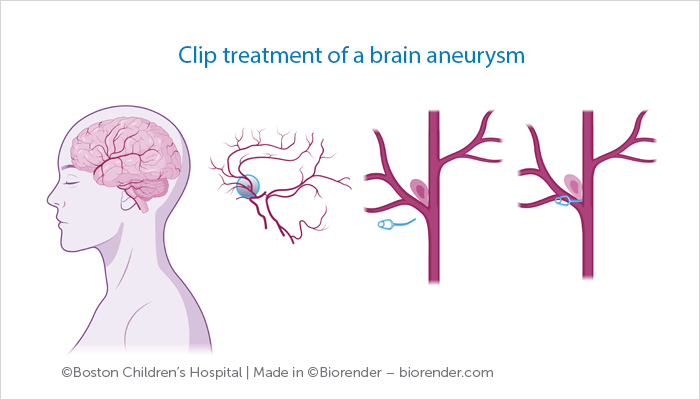Brain Aneurysms | Symptoms & Causes
What are the symptoms of a brain aneurysm?
A brain aneurysm may not cause any symptoms and can go unnoticed until it ruptures. Larger aneurysms, however, may press on brain tissue and nerves, causing complications such as:
- Changes in vision or dilated pupils
- Dizziness
- Numbness on one side of the face
- Pain above or behind one eye
- Seizures
What causes a brain aneurysm?
Brain aneurysms often don’t have a known cause, but they can run in families or be part of a broader genetic disorder, such as Marfan syndrome, Ehlers-Danlos syndrome, Alagille syndrome, PHACE syndrome, moyamoya disease, or polycystic kidney disease.
Brain aneurysms can also result be a result of head trauma, a connective tissue disorder, or an infection.
Brain Aneurysms | Diagnosis & Treatments
How are brain aneurysms diagnosed?
At Boston Children’s, we use a variety of imaging techniques to diagnose brain aneurysms, understand their structure, and evaluate the surrounding areas of the brain.
Our diagnostics include:
- CT (computed tomography) is a noninvasive procedure that uses X-ray equipment and powerful computers to create detailed, cross-sectional images of your child’s body. CT scans typically lasts seconds, but it can take 10 minutes or longer to position the child for the exam.
- Magnetic resonance imaging (MRI) uses a strong magnetic field, radio waves, and advanced computer processing to produce two- and three-dimensional images of the head, neck, and brain. MRIs are noninvasive and are critical in helping evaluate conditions that may be hard to assess with other imaging technologies.
- Angiography uses contrast solution (dye) and imaging technology to map the veins in a part of your child’s body. A cerebral angiography, sometimes called cerebral arteriography or catheter angiography, produces the most detailed images of the blood vessels of the neck, head, and brain using live X-rays. Angiography is performed by a specially trained doctor called an interventional radiologist or a neurointerventional radiologist.
- CT angiography (CTA) uses the technology of a conventional CT scan, along with a special dye known as contrast that’s injected into the body to make images of the blood vessels of your child’s brain.
How are brain aneurysms treated?
At Boston Children’s, your child’s doctor and care team will recommend the best treatment option based the aneurysm’s size and location, as well as their personal vascular anatomy other health factors.
We treat brain aneurysms with both noninvasive (endovascular) and surgical techniques, including:
- Open surgery (clipping): During this procedure, your child’s surgeon will perform a craniotomy to access the aneurysm and the blood vessel that feeds it. A craniotomy is a procedure that temporarily removes part of the bone from the skull to expose the brain. The surgeon will then place a small metal clip on the neck of the aneurysm to stop the blood flow to it.
- Endovascular therapy (coiling): Endovascular coiling is a minimally invasive procedure, meaning your child’s physician won’t access the aneurysm surgically. Instead, a neurointerventional radiologist places a catheter (a flexible tube) into a blood vessel (usually in the groin) and threads it through to the brain. Through this catheter, the doctor will place a ball of coils within the aneurysm to help block blood flow into the aneurysm, reducing or eliminating the risk of rupture.
How we care for brain aneurysms
At Boston Children’s Hospital, our Cerebrovascular Surgery and Interventions Center cares for children and young adults with brain aneurysms and other conditions affecting the blood vessels in and around the brain and spine. The center uses minimally invasive as well as surgical techniques to find and treat these conditions before they cause bleeding or serious brain injury.
If your child’s aneurysm is small and doesn’t pose an immediate health risk, a common course of treatment is to monitor it carefully. Should your child need surgery to treat a brain aneurysm, there are two common approaches to treatment:

Endovascular treatment for an aneurysm involves a neurosurgeon and neurointerventional radiologist placing a hollow plastic tube (catheter) into an artery and threading it through the body to the aneurysm. The surgeon then guides a wire through the catheter and into the aneurysm, where the wire coils up and seals off the artery supplying it with blood.

Open surgery involves a neurosurgeon locating the blood vessel that feeds the aneurysm and placing a small metal clip on the neck of the aneurysm to stop the blood flow.
Brain Aneurysms | Research & Innovation
Our areas of innovation for brain aneurysms
At Boston Children’s, our physicians and researchers are among the most published in their field (see our selected publications).
Our research aims to improve the diagnosis and treatment of brain aneurysms in children. Through our research, we have built a large database that guides and informs our practice and helps us innovate approaches to diagnosis and treatment. Our doctors have also authored and contributed to professional guidelines for stroke and other cerebrovascular conditions, as well as the American Heart Association’s Guidelines for the Management of Cerebrovascular Disorders in Infants and Children.










